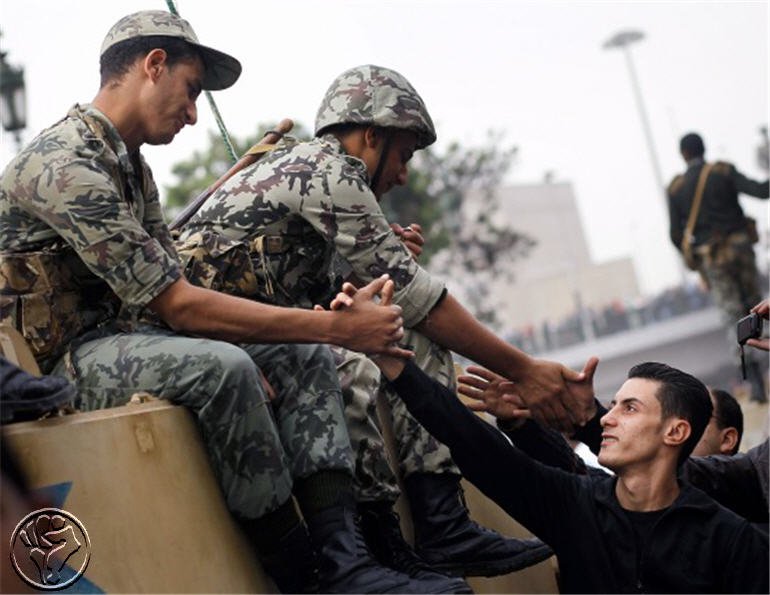A revolution in Egypt: 18 days of tumultuous freedom fighting and a dictator is shamefully evicted. Seems straightforward, doesn't it? It's not. Egyptians have been working toward this outcome for years, yet the manner in which they achieved their revolution is clear-cut. Risking everything, far too often by dying, Egyptians pushed against the regime to gain the freedom to define democracy for themselves. They battled in the most diplomatic way that exists -- in methodical, organized collaboration. Not to mention, with great class. When confronted by what the malicious thugs unleashed upon them, those protesting stood in solidarity. They didn't fight back with artillery, they fought back with unwavering solidarity.
Over the years, adversity did not diminish the fortitude of those advocating change. Despite Emergency Law, which prohibited Egyptians from aggregating in groups of five people or more and permitting unjust arrested, they continued to organize demonstrations, used digital tools to amplify their stories, and applied methods learned from other effective resistance movements to fuel their engine. As opposition groups worked together to maintain momentum and define the stipulations to cease demonstrations, supporters of a free Egypt used technology to build a global community and lured attention to their urgent plea. Although lines of communication had been compromised, those supporters were well aware of the human rights violations.

The impetus to overthrow Hosni Mubarak is attributed to the triumphant ejection of former President of Tunisia, Zine el-Abidine Ben Ali, and subsequent announcement to protest on January 25, 2011 by the creator of the Facebook page, "We Are All Khaled Said." The page united thousands of people in the virtual sphere after the brutal murder of Said, who had been beaten to death by Egyptian police for exposing their torturous customs on video. This, of course, attracted the attention of many opposition groups that also joined the virtual community to honor martyrs regardless of their political and religious ideologies. Those groups perpetuated the call to action by inviting others to join tens of thousands planning to flood the streets of Cairo and Alexandria on January 25th. This landmark event was different than other organized protests. This time, the world was watching. As news traveled, demonstrations of support ignited around the globe.
Ahmed Salah, an Egyptian journalist and activist who had survived torture while incarcerated in jail for pushing against the regime, brought his mission to the United States. He shared his horrifying experiences and optimistic goal of political accountability with fellow activists, media, and politicians as well as participated in trainings on affecting nonviolent change. Salah walked the halls of the United States Capitol lobbying for co-sponsors of House Resolution 200 which, if enough signatures had been secured, would have put conditions on the billions in financial aid that the United States Government gives Egypt without any strings attached. In a Guardian article, "The West's Debt to Egypt," he vividly express the disenchantment he has felt towards western leadership who have turned a blind eye to the corruption and brutalities unearthed by daring citizen journalists and human rights movements.
Ramy Elswissy, a 22-year-old activist, elaborated further when he told me about his 2009 arrest, when he was detained from his family's home without explanation. Police officers interrogated him on why he had started advocating for change in Egypt and tried to scare him away from future advances. "Most of my answers were about wanting an end to the Emergency Law which allowed them to do whatever they wanted ... like arresting and prosecuting people who had not committed a crime," he shared. "I told them that I am an activist seeking human, economic, and political rights. I have no Islamic agenda. I want real democracy." Unlike Salah, Elswissy was later released unscathed. As a result, he became more resolute than ever to achieve reform.

Democratic freedom is a contagious desire evident by a domino effect of uprisings occurring throughout the Middle East. The question is, what qualifies this as a revolution and how can similar outcomes can be achieved? Some of these answers will undoubtedly be defined in retrospect, but in the here and now, value is in identifying what tactics attributed Egyptians success so others can realize the same outcome. Jeff Goodwin, a professor of sociology at New York University, defines a revolution as "any and all instances in which a state or political regime is overthrown and thereby transformed by a popular movement in an irregular, extraconstitutional and/or violent fashion." Take 'violent' out of the equation and that is exactly what happened. The Albert Einstein Institute and International Center for Nonviolent Conflict has produced a myriad of materials, available in several languages, which stimulate critical thinking and showcase the fundamentals that have historically resulted in a revolution. Whether revolutions have been prompted by political, psychological, or socioeconomic revolt, theorists have been analyzing the phenomena for ages. Ironically, both Salah and Elswissy, over 20 years apart in age, have read Gene Sharp's books and refer to their look back at history to help identify what tactics would be fruitful. If history repeats itself, it could be the answer.
From the sidelines we watched government vehicles strike innocent pedestrians, and vigilantes riding camels whip demonstrators, thanks to citizen journalists reporting live from Tahrir Square. Propaganda streaming from State TV became laughable as social media catalyzed what was genuinely transpiring. The gap between demonstrators and observers disintegrated one tweet and YouTube video at a time. With all eyes on Egypt, Mubarak eventually met the opposition of world leaders calling upon him to reform his government, barely stopping short of asking him to step down.
The government that put up technological and life-threatening road blocks eventually fueled their own demise by strengthening their citizens for the final stretch of their revolution. Dictators beware: Strategic use of nonviolent action combined with technology is a lethal formula empowering global citizens seeking your demise. Egyptians defied the remarkable odds of dislodging one of the most powerful men in the world from presidency and won the hearts of the world. Which dictator is next?
Images courtesy of April 6 Youth Movement